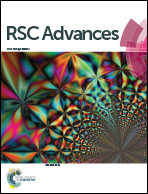An injectable nano-hydroxyapatite (n-HA)/glycol chitosan (G-CS)/hyaluronic acid (HyA) composite hydrogel for bone tissue engineering†
Abstract
The aim of the present study was to fabricate an injectable nano-hydroxyapatite (n-HA)/glycol chitosan (G-CS)/hyaluronic acid (HyA) composite hydrogel and investigate its potent application in bone tissue engineering. The resultant composite hydrogel was thoroughly characterized by Fourier transform infrared spectroscopy (FTIR) and X-ray diffractometry (XRD). The developed composite hydrogels exhibited a porous structure (pore size: 100–350 μm) associated with many n-HA particles and their aggregation inside the hydrogel, as indicated by scanning electron microscopy (SEM). With an increase in HyA concentration, the porosity and swelling ratio of the hydrogels decreased accordingly. The developed composite hydrogels were susceptive to the enzymatic hydrolysis, which exhibited a faster degradation rate in PBS solution containing 2.5 mg ml−1 lysozyme than that of in PBS (pH = 7.4). In vitro cytocompatibility was evaluated by using MC-3T3-E1 cells to confirm that the developed composite hydrogels were cytocompatible, non-toxic and cells were found to be attached and well spread out on the hydrogels after 7 days co-incubation. All these results suggest that the developed composite hydrogels has great potential for bone tissue engineering application.


 Please wait while we load your content...
Please wait while we load your content...